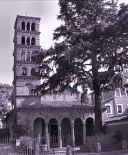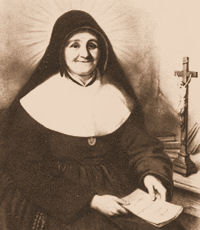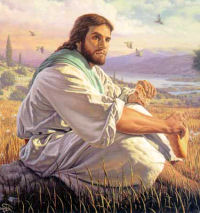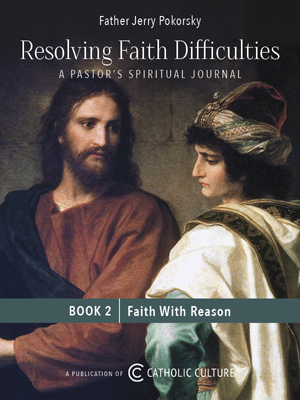Advent: April 8th
Saturday of the Fifth Week of Lent
Other Commemorations: St. Julie Billiart, Virgin (RM)
» Enjoy our Liturgical Seasons series of e-books!
But one of them, Caiaphas, who was high priest that year, said to them, "You know nothing at all; you do not understand that it is expedient for you that one man should die for the people, and that the whole nation should not perish." He did not say this of his own accord, but being high priest that year he prophesied that Jesus should die for the nation, and not for the nation only, but to gather into one the children of God who are scattered abroad (Jn 11:49-52).
| Today's Station takes place in the Church of St. John before the Latin Gate. This ancient basilica is built near the spot where the beloved disciple was, by Domitian's order, plunged into the cauldron of boiling oil. |  |
Meditation - Christ's Last Days
Every person who loves Christ now tries his best to remain close to his suffering Savior during the last hours of His earthly life. The liturgy places us directly in the midst of the recorded events and expects us to participate. During these next days, therefore, we will traverse each road with Jesus.
Yesterday (Friday) He came with His disciples from the desert village of Ephrem to Jericho. When near the Jordan we heard from His lips the third prophecy of the crucifixion. Then Salome approached with her two sons, John and James, and begged important positions for them in the coming kingdom. This gave Jesus the opportunity to proclaim His wonderful teaching on humility. We stand close and listen.
The Lord enters Jericho. I am Zacheus, the chief publican, the little man who wants to see the Messiah from a tree. He looks up to me and says, "Today salvation has come to your house!" He stays two nights with me, a despised publican!
Over the Sabbath Jesus remains in Jericho. The next day (Sunday) He starts for Jerusalem at the head of a lordly caravan. Along the road there sits a blind beggar. It is I, again. "Jesus, Son of David, have mercy on mel" He heals my eyes, I see, I am enlightened!
In procession we pass through Jericho's inhospitable ravines up to Jerusalem. Night intervenes and Jesus stops at Bethany. He is joyously welcomed by Martha and Mary. Am I an active Martha or a meditating Mary? Possibly it was on this Sunday evening that the memorable meal took place when, with Lazarus present and Martha as hostess, Mary poured out the costly ointment for Jesus' burial. It was the act which estranged Judas completely from his Master.
In solemn procession on Monday afternoon the King of Israel comes to the top of Olivet, weeps over Jerusalem, and then continues on to the temple. We feel ourselves part of this festive procession, waving palms in our hands. We accompany our King and watch Him drive the money-changers out of His Father's house. Tuesday morning He returns with His disciples and while crossing Mt. Olivet curses the unfruitful fig tree, a figure of the Jewish people. This barren tree is likewise a warning for us.
Verbal encounters with the Jews take place in the temple courtyard until Wednesday afternoon when Christ hurls His eightfold curse upon Pharisee and Jew, and leaves the temple forever. With His disciples He then proceeds to the Mount of Olives and delivers His powerful discourse on the end of the world and the destruction of Jerusalem. Present in spirit we hear this sermon and take to heart His final admonition, "Be vigilant!" Meanwhile Judas has left the circle of disciples and offers his assistance to the chief priests.
Thursday morning Christ sends Peter and John from Bethany into the city to make the needed preparation for the Passover meal. As evening falls He bids farewell to His mother and His friends and goes with His apostles to the Upper Room in Jerusalem for His "Last Supper" with them.—In mind and in heart we will follow our Blessed Lord closely during these sacred days of Holy Week.
St. Julie Billiart
 Saint Julie was a woman completely immersed in God’s love and goodness, even in the midst of great suffering. She was a woman of vision who responded to the needs of the suffering world around her.
Saint Julie was a woman completely immersed in God’s love and goodness, even in the midst of great suffering. She was a woman of vision who responded to the needs of the suffering world around her.
Born in Cuvilly, France, on July 12, 1751, Julie lived a humble life in a loving family. She was a woman of serenity, despite the great personal suffering she endured. The Billiart family survived many hardships, including the deaths of several children. When Julie was 16, she went to work to help support her family. At the age of 23 she became paralyzed by the trauma of a shooting that was aimed at her father. She spent more than 20 years confined to her bed, unable to care for even her most basic needs.
Besides her physical pain, Julie suffered religious persecution, lived in hiding as a refugee. Throughout her suffering, she steadfastly trusted in God’s goodness. At the age of 53, Julie and her very good friend, Françoise Blin de Bourdon, along with two other women, made their vows as Sisters of Notre Dame in Amiens, France. A variety of difficult circumstances caused her to move her congregation to Namur, Belgium, several years later. Today these sisters are known as the Sisters of Notre Dame de Namur. Julie’s spirit and charism also influenced the Sisters of Notre Dame of Amersfoort, The Netherlands, as well as our own congregation of the Sisters of Notre Dame, which began in Coesfeld, Germany.
Julie reached out to the poor and forgotten, she brought comfort and hope to those around her, she encouraged faith in the seeking and the lost. More than anything else, she was a witness to the deep, loving goodness of God. Her motto and mantra was: “Oh, how good God is!” In 1969 Julie was named a saint by the Catholic Church. The impact that Saint Julie had on the world continues through the life and ministry of the sisters who share in her heritage.
—Excerpted from The Sisters of Notre Dame
Patronage: against poverty; bodily ills; impoverishment; poverty; sick people; sickness
Highlights and Things to Do:
- Read more about St. Julie:
- The Sisters of Notre Dame de Namur are still active.






